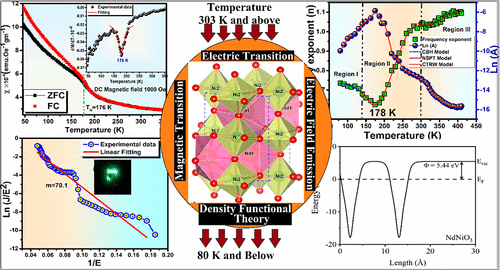Research at the Department of Physics is currently exploring the potential applications of NdNiO3. Recently, Professor Ranjit Thapa, and his Ph D student, Mr Deepak S Gavali published the paper, Low-Temperature Spin-Canted Magnetism and Bipolaron Freezing Electrical Transition in Potential Electron Field Emitter NdNiO3 in the journal ACS Applied Electronic Materials, with an Impact Factor of 3.314. This work is done in collaboration with the Department of Physics and Astronomy, National Institute of Technology Rourkela, Rourkela, Odisha, India.
About the research
 In this work, NdNiO3 nanoparticles are synthesized by sol-gel auto-combustion techniques, and its primary characterization related to structural and surface morphological analysis is carried out by X-Ray Diffraction (XRD), Fourier Transforms Infrared Spectroscopy (FTIR), Field Emission Scanning Electron Microscopy (FESEM), Energy-Dispersive X-ray spectroscopy (EDX), and Transmission Electron Microscopy (TEM) techniques. The research is focused on magnetic phase transition below Curie temperature (TN) ∼176 K, and the magnetic susceptibility indicates a weak antiferromagnetic ordering at low temperature. Different ac conduction mechanisms, that is, Correlated Barrier Hopping (CBH), Continuous-Time Random Walk (CTRW) conduction model, and Non-overlapping Small Polaron Tunneling (NSPT), are introduced to interpret its electrical transport behavior near, above, and below TMI ∼178 K. Using first principles and Density of States (DOS) calculation, the researchers have characterized the electronic and magnetic ground state of NdNiO3 at room temperature. It exposed the overlapping of conduction and valence band at room temperature, and the degree of hybridization between Ni 3d and O 2p is very high compared to Nd 5d states. The work function is also calculated for a few-layer NdNiO3 to estimate the field enhancement factor (β), which plays a crucial role in the practical application of a field emitter.
In this work, NdNiO3 nanoparticles are synthesized by sol-gel auto-combustion techniques, and its primary characterization related to structural and surface morphological analysis is carried out by X-Ray Diffraction (XRD), Fourier Transforms Infrared Spectroscopy (FTIR), Field Emission Scanning Electron Microscopy (FESEM), Energy-Dispersive X-ray spectroscopy (EDX), and Transmission Electron Microscopy (TEM) techniques. The research is focused on magnetic phase transition below Curie temperature (TN) ∼176 K, and the magnetic susceptibility indicates a weak antiferromagnetic ordering at low temperature. Different ac conduction mechanisms, that is, Correlated Barrier Hopping (CBH), Continuous-Time Random Walk (CTRW) conduction model, and Non-overlapping Small Polaron Tunneling (NSPT), are introduced to interpret its electrical transport behavior near, above, and below TMI ∼178 K. Using first principles and Density of States (DOS) calculation, the researchers have characterized the electronic and magnetic ground state of NdNiO3 at room temperature. It exposed the overlapping of conduction and valence band at room temperature, and the degree of hybridization between Ni 3d and O 2p is very high compared to Nd 5d states. The work function is also calculated for a few-layer NdNiO3 to estimate the field enhancement factor (β), which plays a crucial role in the practical application of a field emitter.
Practical implications
The additional novelty of the present work is to explore the potential application of NdNiO3 as an efficient field emitter and controlled electron/X-ray sources in a flat panel display, microwave vacuum electronic devices, electron microscopy/ lithography, and so forth. To eject conducting electrons from the metal/semiconducting surface by a quantum mechanical tunneling process, sufficient energy is required in terms of the applied electric field (∼106 to 107 V/cm) to overcome the potential barrier at the vacuum−metal interface. The potential difference between the Fermi level (Ef ) of the metal surface to vacuum is known as the work function (Φ). It depends on material characteristics and plays an essential role in field enhancement capability. The primary requirement for efficient field emitters is high aspect ratios (i.e., field enhancement factor), inferior turn-in field, low work, function, etc. Researchers have examined various classes of materials for efficient field emitter electrodes, such as (i) carbonaceous materials like graphene and carbon nanotube, (ii) various 1D and 2D metal oxide and transition metal dichalcogenides like ZnO, MnO2, In2O3, WS2, WSe2, MoS2, PdSe2, etc., (iii) inorganic semiconductors like SiC and Si, and (iv) wide band gap semiconducting compounds GaN, AIN, and so on. The field emission properties of rare earth nickelates (RNiO3; R = La, Gd, Nd, Sm, etc.) with an exciting room temperature metallic nature have not been examined.

